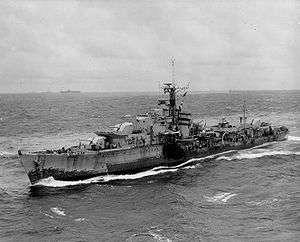HMS Terpsichore (R33)
 | |
| History | |
|---|---|
| Name: | HMS Terpischore |
| Ordered: | 13 March 1941 |
| Builder: | William Denny & Brothers, Dumbarton, Scotland |
| Laid down: | 25 November 1941 |
| Launched: | 17 June 1943 |
| Commissioned: | 20 January 1944 |
| Recommissioned: | 1954 |
| Decommissioned: | 1946 |
| Out of service: | 1960 |
| Identification: | Pennant number: R33, D48 (1945), F19 (NATO) |
| Fate: | Scrapped at Troon in May 1966 |
| General characteristics | |
| Class and type: | T-class destroyer |
| Displacement: | |
| Length: | 362 ft 9 in (110.6 m) (o/a) |
| Beam: | 35 ft 9 in (10.9 m) |
| Draught: | 14 ft 6 in (4.4 m) (deep) |
| Installed power: |
|
| Propulsion: | 2 × shafts; 2 × Parsons geared steam turbines |
| Speed: | 36 knots (67 km/h; 41 mph) |
| Range: | 4,675 nmi (8,658 km; 5,380 mi) at 20 knots (37 km/h; 23 mph) |
| Sensors and processing systems: |
|
| Armament: |
|
HMS Terpsichore was a T-class destroyer built for the Royal Navy during the Second World War.
Description
Terpsichore displaced 1,710 long tons (1,740 t) at standard load and 2,530 long tons (2,570 t) at deep load. She had an overall length of 362 feet 9 inches (110.6 m), a beam of 35 feet 8 inches (10.9 m) and a deep draught of 14 feet 6 inches (4.4 m). She was powered by two Parsons geared steam turbines, each driving one propeller shaft, using steam provided by two Admiralty three-drum boilers. The turbines developed a total of 40,000 shaft horsepower (30,000 kW) and gave a maximum speed of 36 knots (67 km/h; 41 mph). Terpsichore carried a maximum of 615 long tons (625 t) of fuel oil that gave her a range of 4,675 nautical miles (8,658 km; 5,380 mi) at 20 knots (37 km/h; 23 mph). Her complement was 170 officers and ratings.[1]
The ship was armed with four 45-calibre 4.7-inch (120 mm) Mark XII guns in dual-purpose mounts. For anti-aircraft (AA) defence, Terpsichore had one twin mount for Bofors 40 mm guns and four twin 20-millimetre (0.8 in) Oerlikon autocannon. She was fitted with two above-water quadruple mounts for 21-inch (533 mm) torpedoes. Two depth charge rails and four throwers were fitted for which 70 depth charges were provided.[2]
Construction and career
In August 1945 Terpsichore was sent to Japan, under the command of Commander R.T. White D.S.O.** (later Captain R.T. White D.S.O.**, 2nd son of Sir Archibald White, Bt. of Wallingwells), as the lead destroyer in the escort group of the USS Mississippi (BB-41) into Tokyo Bay. Commander White witnessed the surrender of the Japanese Forces and received a surrendered Samurai sword from the Japanese.
Between 1946 and 1953 Terpsichore was held in reserve at Devonport. Between 1953 and 1954 she was converted to a Type 16 fast anti-submarine frigate, by Thornycroft, Woolston, with the new pennant number F19.[3] In 1955 she was placed in reserve in Devonport, undergoing a refit there in December 1957. Between 1960 and 1966 Terpsichore was held in reserve at Lisahally. She was subsequently sold for scrap and arrived at Troon on 17 May 1966.
References
Bibliography
- Chesneau, Roger, ed. (1980). Conway's All the World's Fighting Ships 1922–1946. Greenwich, UK: Conway Maritime Press. ISBN 0-85177-146-7.
- Colledge, J. J.; Warlow, Ben (2006) [1969]. Ships of the Royal Navy: The Complete Record of all Fighting Ships of the Royal Navy (Rev. ed.). London: Chatham Publishing. ISBN 978-1-86176-281-8. OCLC 67375475.
- Critchley, Mike (1982). British Warships Since 1945: Part 3: Destroyers. Liskeard, UK: Maritime Books. ISBN 0-9506323-9-2.
- English, John (2001). Obdurate to Daring: British Fleet Destroyers 1941–45. Windsor, UK: World Ship Society. ISBN 978-0-9560769-0-8.
- Lenton, H. T. (1998). British & Empire Warships of the Second World War. Annapolis, Maryland: Naval Institute Press. ISBN 1-55750-048-7.
- Raven, Alan; Roberts, John (1978). War Built Destroyers O to Z Classes. London: Bivouac Books. ISBN 0-85680-010-4.
- Whitley, M. J. (1988). Destroyers of World War 2. Annapolis, Maryland: Naval Institute Press. ISBN 0-87021-326-1.